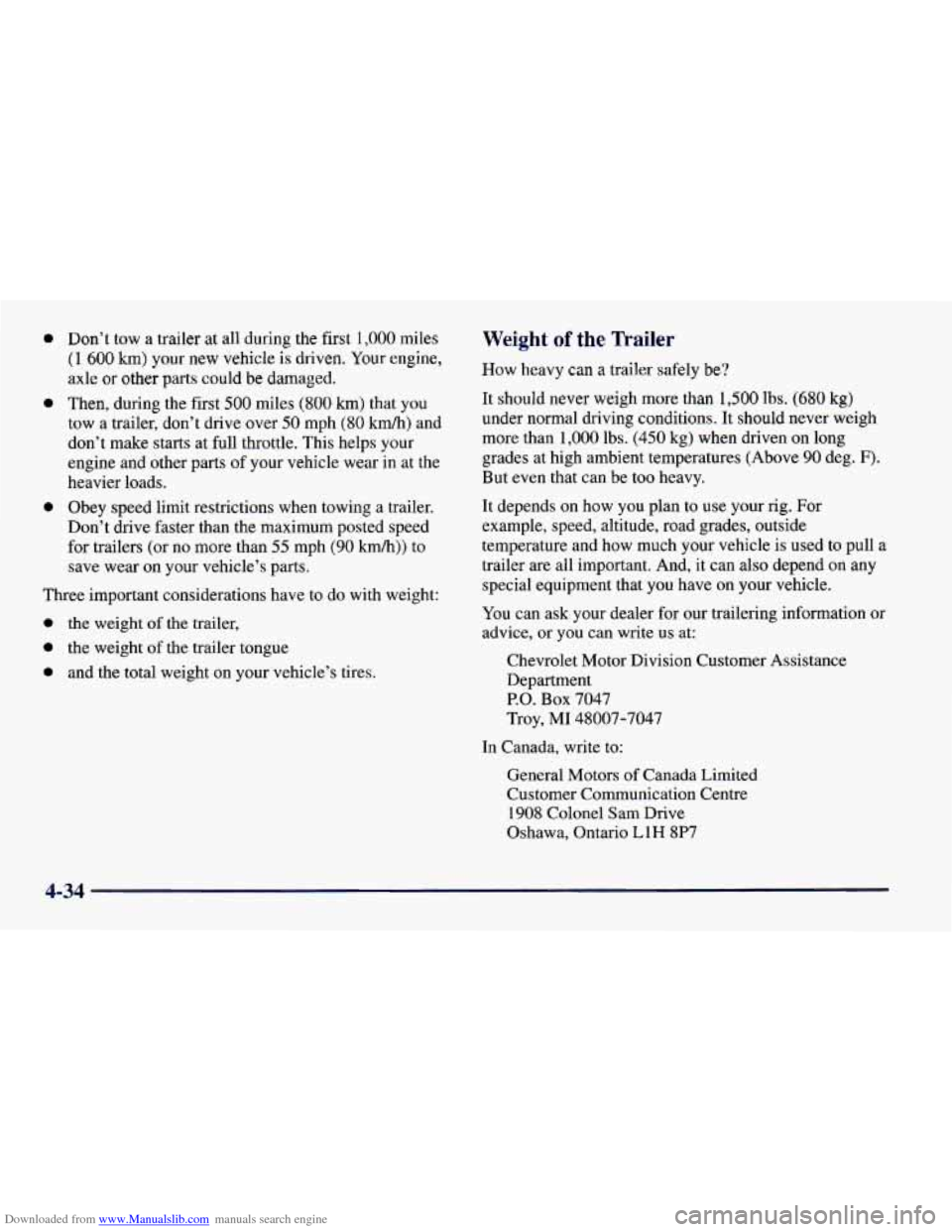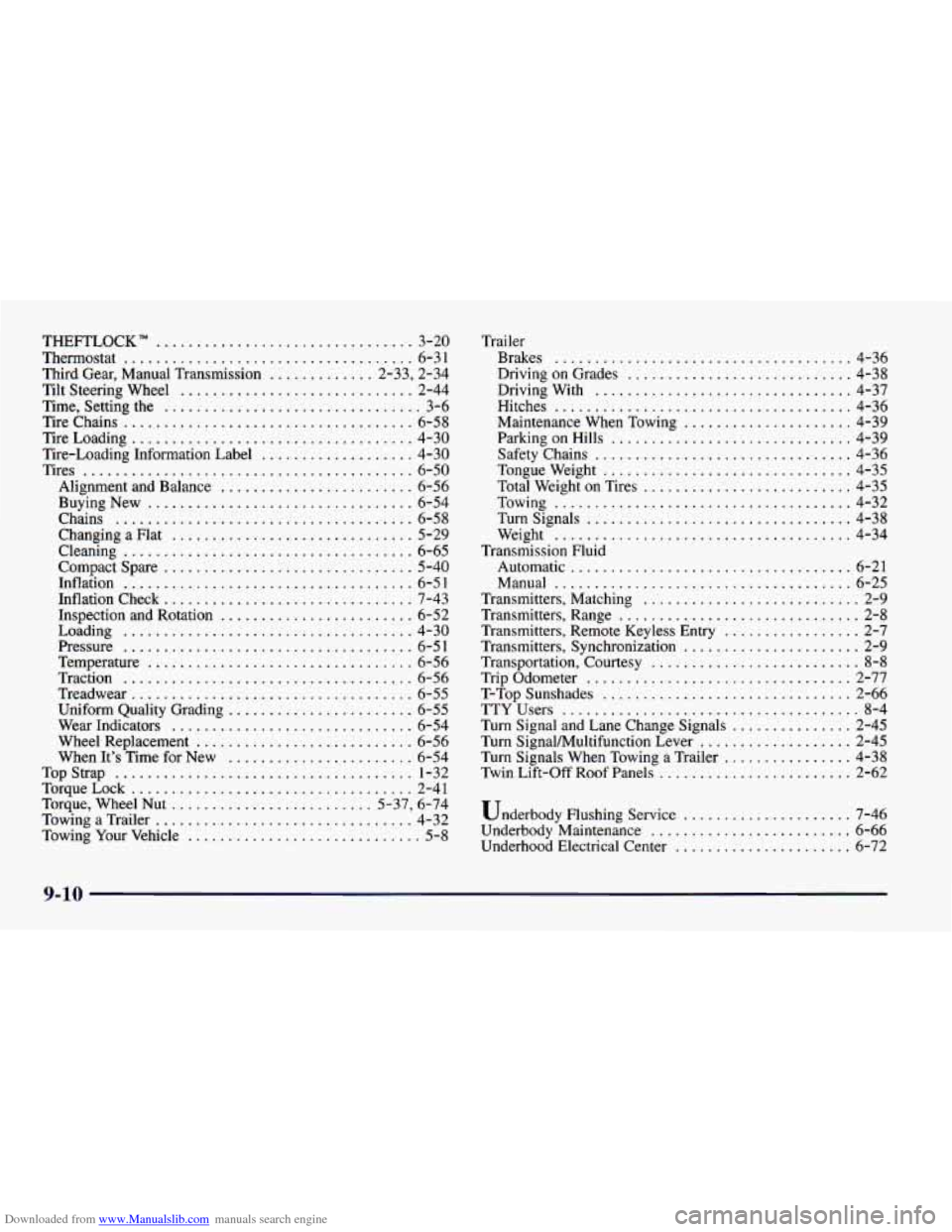1997 CHEVROLET CAMARO weight
[x] Cancel search: weightPage 197 of 404

Downloaded from www.Manualslib.com manuals search engine NOTICE:
Pulling a trailer improperly can damage your
vehicle and result in costly repairs not covered by
your warranty. To pull a trailer correctly, follow
the advice in this part, and see your Chevrolet
dealer for important information about towing
a
trailer with your vehicle.
Your vehicle can tow a trailer if it is equipped with
either the
3800 or the 5.7L engine and proper trailer
towing equipment. To identify what the vehicle
trailering capacity is for your vehicle, you should read
the information in “Weight of the Trailer” that appears
later in this section. But trailering
is different than just
driving your vehicle by itself. Trailering means changes
in handling, durability and fuel economy. Successful,
safe trailering takes correct equipment, and it has
to be
used properly. That’s
the reason
for this part. In it are many
time-tested, important trailering tips and safety rules.
Many
of these are important for your safety and that of
your passengers.
So please read this section carefully
before
you pull a trailer.
Load-pulling components such as the engine,
transmission, rear axle, wheel assemblies and tires are
forced
to work harder against the drag of the added
weight. The engine is required to operate at relatively
higher speeds and under greater loads, generating extra
heat. What’s more, the trailer adds considerably
to wind
resistance, increasing the pulling requirements.
If You Do Decide To Pull A Trailer
If you do, here are some important points:
There are many different laws, including speed limit
restrictions, having to do with trailering. Make sure
your rig will
be legal, not only where you live but
also where you’ll be driving. A good source for this
information can be state or provincial police.
0 Consider using a sway control. You can ask a hitch
dealer about sway controls.
4-33
Page 198 of 404

Downloaded from www.Manualslib.com manuals search engine a
0
0
Don’t tow a trailer at all during the first 1,000 miles
(1 600 km) your new vehicle is driven. Your engine,
axle
or other parts could be damaged.
Then, during the first
500 miles (800 km) that you
tow a trailer, don’t drive over
50 mph (80 km/h) and
don’t make starts at full throttle. This helps your
engine and other parts of your vehicle wear in at the
heavier loads.
Obey speed limit restrictions when towing a trailer.
Don’t drive faster than the maximum posted speed
for trailers (or no more than
55 mph (90 km/h)) to
save wear on your vehicle’s parts.
Three important considerations have to do with weight:
0 the weight of the trailer,
0 the weight of the trailer tongue
0 and the total weight on your vehicle’s tires.
Weight of the Trailer
How heavy can a trailer safely be?
It should never weigh more than 1,500 lbs. (680 kg)
under normal driving conditions. It should never weigh
more than
1,000 lbs. (450 kg) when driven on long
grades at high ambient temperatures (Above
90 deg. F).
But even that can be too heavy.
It depends on how you plan to use your rig. For
example, speed, altitude, road grades, outside temperature and how much your vehicle is used to pull a
trailer
are all important. And, it can also depend on any
special equipment that you have
on your vehicle.
You can ask your dealer for our trailering information or
advice, or you can write us at:
Chevrolet Motor Division Customer Assistance
Department
P.O. Box 7047
Troy,
MI 48007-704;‘
In Canada, write to:
General Motors
of Canada Limited
Customer Communication Centre
1908 Colonel Sam Drive
Oshawa, Ontario L1H 8P7
4-34
Page 199 of 404

Downloaded from www.Manualslib.com manuals search engine Weight of the Trailer Tongue
The tongue load (A) of any trailer is an important
weight
to measure because it affects the total capacity
weight of
your vehicle. The capacity weight includes the
curb weight of the vehicle, any cargo you may carry in
it, and the people who will
be riding in the vehicle. And
if you will tow a trailer, you must subtract the tongue
load from your vehicle’s capacity weight because your
vehicle will be carrying that weight, too.
See “Loading
Your Vehicle” in the Index for more information about
your vehicle’s maximum load capacity.
A B
If you’re using a weight-carrying hitch, the trailer
tongue
(A) should weigh 10 percent of the total loaded
trailer weight (B). If you have a weight-distributing
hitch, the trailer tongue
(A) should weigh 12 percent of
the total loaded trailer weight (B).
After you’ve loaded your trailer, weigh the trailer and
then the tongue, separately,
to see if the weights are
proper.
If they aren’t, you may be able to get them right
simply by moving some items around
in the trailer.
Total Weight on Your Vehicle’s Tires
Be sure your vehicle’s tires are inflated to the upper
limit for cold tires. You’ll find these numbers on the
Certification label
at the rear edge of the driver’s door or
see “Loading Your Vehicle” in the Index. Then be sure
you don’t go over the GVW limit for your vehicle,
including the weight of the trailer tongue.
4-35
Page 201 of 404

Downloaded from www.Manualslib.com manuals search engine Driving with a Trailer
Towing a trailer requires a certain amount of experience.
Before setting out for the open road, you’ll want
to get
to know your rig. Acquaint yourself with the feel of
handling and braking with the added weight of the
trailer. And always keep in mind that the vehicle you are
driving is now a good deal longer and not nearly as
responsive as your vehicle is by itself.
Before you start, check the trailer hitch and platform
(and attachments), safety chains, electrical connector,
lamps, tires and mirror adjustment.
If the trailer has
electric brakes, start your vehicle and trailer moving and
then apply the trailer brake controller by hand to be sure
the brakes are working. This lets you check your
electrical connection at the same time.
During
your trip, check occasionally to be sure that the
load
is secure, and that the lamps and any trailer brakes
are still working.
Following Distance
Stay at least twice as far behind the vehicle ahead as you
would when driving your vehicle without a trailer.
This
can help you avoid situations that require heavy braking
and sudden turns.
Passing
You’ll need mofe passing distance up ahead when
you’re towing a trailer. And, because you’re a good
deal longer, you’ll need
to go much farther beyond the
passed vehicle before you can return to your lane.
Backing Up
Hold the bottom of the steering wheel with one hand.
Then, to move the trailer
to the left, just move that hand
to the left. To move the trailer to the right, move your
hand to the right. Always back up slowly and, if
possible, have someone guide
you.
4-37
Page 395 of 404

Downloaded from www.Manualslib.com manuals search engine Gages Engine Coolant Temperature
.................... 2-83
Engine Oil Pressure
........................... 2-87
Fuel
....................................... 2-89
GAWR
....................................... 4-31
Gear Positions. Automatic Transmission
............. 2-29
Gear Positions. Manual Transmission
............... 2-32
GloveBox
.................................... 2-58
Gross Axle Weight Rating
........................ 4-3 1
Gross Vehicle Weight Rating ...................... 4-31
Guide
en FranGais 11 .. .................................
GVWR ........................................ 4-31
Halogen Bulbs
................................ 6-40
Hatch
........................................ 2-11
Hatch Release
.................................. 2- 12
Hatch Release. Remote
.......................... 2-12
Hazard Warning Flashers .......................... 5-2
Headlamps
.................................... 2-52
Aiming
..................................... 6-40
Bulb Replacement
............................ 6-40
HighLow Beamchanger
...................... 2-46
OnReminder
................................ 2-52
Wiring
..................................... 6-69
Hearing Impaired. Customer Assistance .............. 8-4
Heating
........................................ 3-4
High-Beam Headlamps
.......................... 2-46
Highway Hypnosis
.............................. 4-24
Hill and Mountain Roads
......................... 4-24
Hitches, Trailer
................................. 4-36
Hood Checking Things Under
......................... 6-8
Release ...................................... 6-9 Horn
......................................... 2-44
Hydraulic Clutch
............................... 6-26
Hydraulic Clutch System Check
................... 7-44
Hydroplaning
.................................. 4-20
Ignition Positions
.............................. 2-24
Inflation. Tire
.................................. 6-51
Inside Daymight Rearview Mirror
................. 2-56
Inspections
.................................... 7-47
Brakesystem
................................ 7-48
CalipedKnuckle Maintenance
................... 7-48
Exhaust Systems
............................. 7-47
Radiator and Heater Hose
...................... 7-47
RearAxle
................................... 7-47
Steering
.................................... 7-47
Suspension
.................................. 7-47
Throttle Linkage
.............................. 7-47
Instrument Panel
............................... 2-74
Brightness Control
............................ 2-54
Cluster
..................................... 2-76
Interior Lamps
................................. 2-55
Cleaning
.................................... 6-62
.................................... J ack. Tire
5-31
Jump Starting
................................... 5-3
Key Lock Cylinders Service ..................... 7-44
Key Release Button
............................. 2-25
Keys
.......................................... 2-2
Page 400 of 404

Downloaded from www.Manualslib.com manuals search engine THEFTLOCK" ................................ 3-20
Thermostat
.................................... 6-31
Third Gear. Manual Transmission
............. 2.33. 2.34
Tilt Steering Wheel
............................. 2-44
Time. Setting the
................................ 3-6
Tire Chains .................................... 6-58
Tire Loading
................................... 4-30
Tire-Loading Information Label
................... 4-30
Tires
......................................... 6-50
Alignment and Balance
........................ 6-56
Chains
..................................... 6-58
Cleaning
.................................... 6-65
Inflation
.................................... 6-51
Inflation Check
............................... 7-43
Inspection and Rotation
........................ 6-52
Loading
.................................... 4-30
Pressure
.................................... 6-51
Temperature
................................. 6-56
Traction
.................................... 6-56
Treadwe ar
................................... 6-55
Uniform Quality Grading
....................... 6-55
Wear Indicators
.............................. 6-54
Wheel Replacement
........................... 6-56
When It's Time for New
....................... 6-54
TopStrap
..................................... 1-32
TorqueLock
................................... 2-41
Torque. Wheel Nut
......................... 5-37. 6-74
Buying New
................................. 6-54
Changing a Flat
.............................. 5-29
Compact Spare
............................... 5-40
Towing a Trailer
................................ 4-32
Towing Your Vehicle
............................. 5-8 Trailer
Brakes
..................................... 4-36
Driving on Grades
............................ 4-38
Driving With
................................ 4-37
Hitches
..................................... 4-36
Maintenance When Towing
..................... 4-39
Parking on Hills
.............................. 4-39
Tongueweight
............................... 4-35
Total Weight on Tires
.......................... 4-35
Towing
..................................... 4-32
Turn Signals
................................. 4-38
Weight
..................................... 4-34
Automatic
................................... 6-21
Manual
..................................... 6-25
Transmitters. Matching
........................... 2-9
Transmitters. Range
.............................. 2-8
Transmitters. Remote Keyless Entry
................. 2-7
Transmitters. Synchronization
...................... 2-9
Safety Chains
................................ 4-36
Transmission Fluid
Transportation. Courtesy
.......................... 8-8
Trip Odometer
................................. 2-77
T-Topsunshades
............................... 2-66
TTYUsers
..................................... 8-4
Turn Signal and Lane Change Signals
............... 2-45
Turn Signalhlultifunction Lever
................... 2-45
Turn Signals When Towing a Trailer
................ 4-38
Twin Lift-off
Roof Panels ........................ 2-62
Underbody Flushing Service
..................... 7-46
Underbody Maintenance
......................... 6-66
Underhood Electrical Center
...................... 6-72
9-10